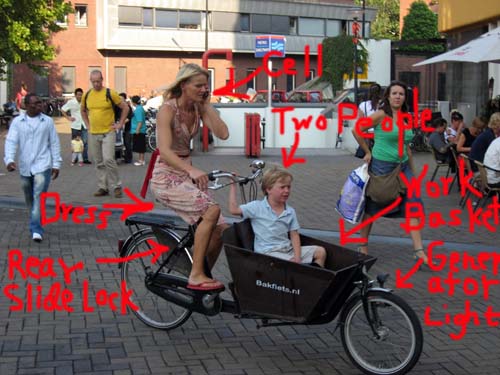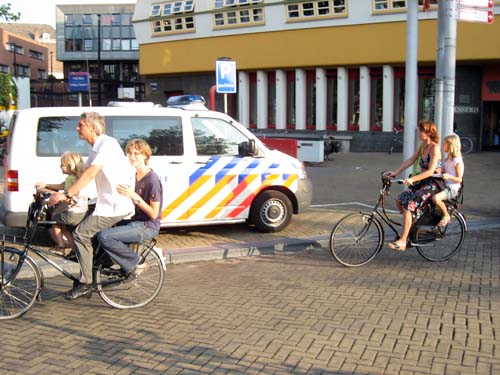waterloowarrior
Senior Member
Comment: Cyclists need regulating
Posted: September 14, 2009, 9:30 PM by Rob Roberts
http://network.nationalpost.com/np/...9/09/14/comment-cyclists-need-regulating.aspx
Comment by Kelly McParland, National Post
Michael Walker, a conservative member of Toronto's city council, is backing a proposal on cycling that should be embraced across the country, and expanded exponentially.
Mr. Walker says cyclists who use city streets should not only be required to wear helmets, but should be licensed as well. Predictably, the same cyclists who want equal access to city roads are against any of the regulations that apply to other vehicles. Yvonne Bambrick, executive director of the Toronto Cyclists Union, says they would act as "barriers to entry" to new cyclists. Bike fans say helmets don't really protect anyone anyway.
So what? Helmets don't do a lot to save motorcyclists who go flying into a transport truck at full speed either, but bikers are required to wear one. And it's not the helmet aspect of Walker's proposal that should be embraced, it's the requirement for licensing.
If cyclists want to share the roads with cars, trucks, trailers, motorcycles and even hot dog wagons, all of which have to be licensed, why should they be the exception? Cycling in the city, as they never tire of telling us, is dangerous, even deadly. So why should the most vulnerable people out there, the ones certain to come off worse in any collision, be the only group to operate without any form of organized training or formal licensing?
If anything, licensing alone is inadequate. Cyclists should be required to wear the same forms of protective clothing motorcyclists typically use to provide some measure of safety. Cycling in main arteries should be limited to age groups mature enough to deal with the dangers and uncertainties of heavy traffic. There should be a system of regular testing and strict enforcement, just as with other vehicles. Cyclists should be required to strictly follow traffic regulations, which means obeying all stop signs, signal lights, one-way streets and parking regulations. There is no reason bikes should be allowed to weave in and out of traffic, skip through stop signs or take short cuts that would be barred to other traffic.
There is also no reason cyclists should be exempt from regulations against the use of hand-held devices while in control of their vehicle; head phones of any sort should be specifically banned, as the danger of a cyclist unable to hear what's going on around them is self-evident.
Bicycle enthusiasts are vehement in proclaiming their rights and demanding equal treatment when they want access to the roads, but are utterly unwilling to observe the kind of restrictions, precautions and safety measures everyone else takes for granted. There is no reason they should have a blanket exemption from common sense. The more bikes on the road, the greater the need for regulation. Mr. Walker should push his proposal hard, and make it much broader than its current limited state.
LOL @ wearing motorcycle safety equipment.. I'd better put on my kevlar suit and leather jacket next time I want to go down the block.


Posted: September 14, 2009, 9:30 PM by Rob Roberts
http://network.nationalpost.com/np/...9/09/14/comment-cyclists-need-regulating.aspx
Comment by Kelly McParland, National Post
Michael Walker, a conservative member of Toronto's city council, is backing a proposal on cycling that should be embraced across the country, and expanded exponentially.
Mr. Walker says cyclists who use city streets should not only be required to wear helmets, but should be licensed as well. Predictably, the same cyclists who want equal access to city roads are against any of the regulations that apply to other vehicles. Yvonne Bambrick, executive director of the Toronto Cyclists Union, says they would act as "barriers to entry" to new cyclists. Bike fans say helmets don't really protect anyone anyway.
So what? Helmets don't do a lot to save motorcyclists who go flying into a transport truck at full speed either, but bikers are required to wear one. And it's not the helmet aspect of Walker's proposal that should be embraced, it's the requirement for licensing.
If cyclists want to share the roads with cars, trucks, trailers, motorcycles and even hot dog wagons, all of which have to be licensed, why should they be the exception? Cycling in the city, as they never tire of telling us, is dangerous, even deadly. So why should the most vulnerable people out there, the ones certain to come off worse in any collision, be the only group to operate without any form of organized training or formal licensing?
If anything, licensing alone is inadequate. Cyclists should be required to wear the same forms of protective clothing motorcyclists typically use to provide some measure of safety. Cycling in main arteries should be limited to age groups mature enough to deal with the dangers and uncertainties of heavy traffic. There should be a system of regular testing and strict enforcement, just as with other vehicles. Cyclists should be required to strictly follow traffic regulations, which means obeying all stop signs, signal lights, one-way streets and parking regulations. There is no reason bikes should be allowed to weave in and out of traffic, skip through stop signs or take short cuts that would be barred to other traffic.
There is also no reason cyclists should be exempt from regulations against the use of hand-held devices while in control of their vehicle; head phones of any sort should be specifically banned, as the danger of a cyclist unable to hear what's going on around them is self-evident.
Bicycle enthusiasts are vehement in proclaiming their rights and demanding equal treatment when they want access to the roads, but are utterly unwilling to observe the kind of restrictions, precautions and safety measures everyone else takes for granted. There is no reason they should have a blanket exemption from common sense. The more bikes on the road, the greater the need for regulation. Mr. Walker should push his proposal hard, and make it much broader than its current limited state.
LOL @ wearing motorcycle safety equipment.. I'd better put on my kevlar suit and leather jacket next time I want to go down the block.






